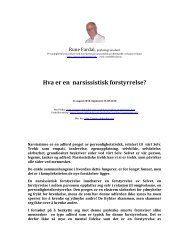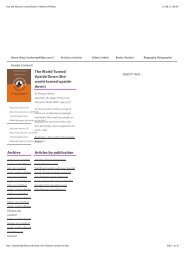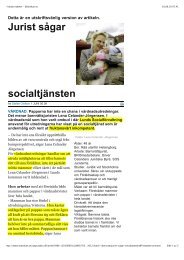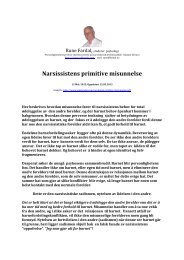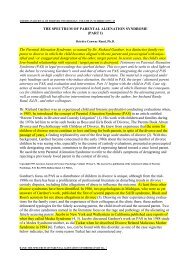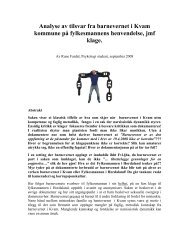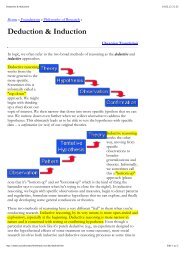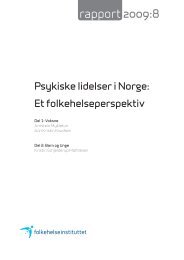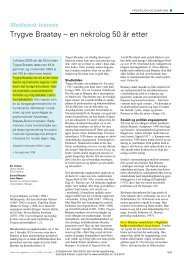The origins of narcissism and narcissistic personality disorder a
The origins of narcissism and narcissistic personality disorder a
The origins of narcissism and narcissistic personality disorder a
Create successful ePaper yourself
Turn your PDF publications into a flip-book with our unique Google optimized e-Paper software.
THE ORIGINS OF NARCISSISM 79<br />
(1965) 8-month stranger anxiety, with its shyness, lowered head, <strong>and</strong><br />
lowered eyes, may also be a preverbal shame display.<br />
<strong>The</strong>se prereflective shame phenomena, along with experimental<br />
demonstration that infants can become extremely distressed when their<br />
parents are emotionally unresponsive for even brief periods (Tronick<br />
et al., 1978), indicate that the traditional psychoanalytic hypothesis <strong>of</strong><br />
infantile omnipotence (e.g., Ferenczi, 1913/1950; Freud, 1900/1953,<br />
1911/1958a, 1913/1955; Grunberger, 1971/1979; Mahler et al., 1975;<br />
Winnicott, 1960) is in error (see Holt, 1967/1989; Horner, 1985; Peterfreund,<br />
1978). According to this dubious notion, infants less than 6<br />
months old, when frustrated, satisfy their needs through hallucination,<br />
<strong>and</strong> preverbal infants older than age 6 months resort to wishful or<br />
magical thinking.<br />
Aside from the sheer implausibility <strong>of</strong> normal hallucinations in neonates<br />
(Holt, 1967/1989; Horner, 1985) <strong>and</strong> the likelihood that magical<br />
thinking requires capacities for language <strong>and</strong> symbolic thought (Gramont,<br />
1990; Stern, 1985), it is certain that the prereflective infant, like<br />
any other nonverbal mammalian organism, experiences failure, inefficacy,<br />
affect misattunement, <strong>and</strong> frustration <strong>and</strong> is unable to wish away<br />
these states. Because even prereflective shame calls attention to defects<br />
<strong>and</strong> limitations <strong>of</strong> the self <strong>and</strong> to disruptions <strong>of</strong> interpersonal relatedness<br />
(H. B. Lewis, 1980, 1987), shame is the crucial <strong>narcissistic</strong> affect<br />
(Wurmser, 1981, 1987), the opposite <strong>of</strong> pride (Nathanson, 1987) <strong>and</strong><br />
an attenuator <strong>of</strong> interest <strong>and</strong> enjoyment; it constitutes the affective core<br />
<strong>of</strong> <strong>narcissistic</strong> injuries-<strong>of</strong> blows to self-concept <strong>and</strong> self-esteem (Broucek,<br />
1982; Kinston, 1983; Wurmser, 1987).<br />
<strong>The</strong> absence <strong>of</strong> objective self-awareness during the first year <strong>of</strong> life,<br />
however, means that infants, although not living in a world <strong>of</strong> omnipotence,<br />
do manifest a certain elevation <strong>of</strong> mood, much as Duval<br />
<strong>and</strong> Wicklund’s (1972) analysis <strong>of</strong> self-reflexivity in adults suggests.<br />
This euthymia emerges in the practicing subphase (ages 9 to 15<br />
months), when the achievement <strong>of</strong> upright locomotion propels the<br />
child to separate from mother, exp<strong>and</strong>s the infant’s horizons, <strong>and</strong> provides<br />
a sense <strong>of</strong> exhilaration (Mahler et al., 1975). <strong>The</strong> emergence <strong>of</strong><br />
objective self-awareness brings to a close the euphoria <strong>of</strong> the practicing<br />
stage <strong>and</strong> calls forth for the first time shame affect proper. <strong>The</strong> concurrence<br />
<strong>of</strong> these developments is no coincidence. <strong>The</strong> ability to regard<br />
oneself as an object-as indexed by the capacity for self-recognition in<br />
the mirror, in photographs, <strong>and</strong> on videotape-is consolidated between




